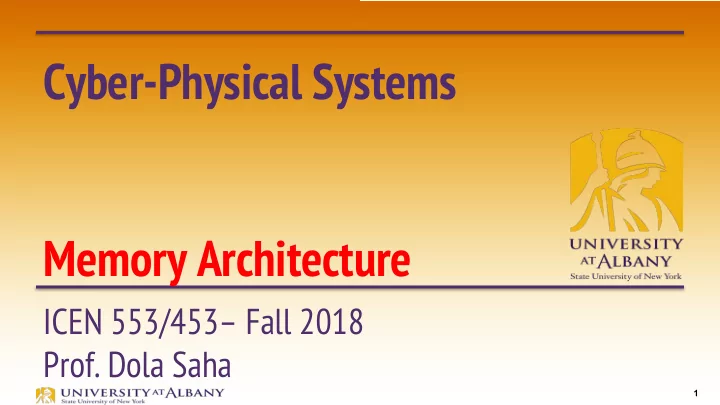

Cyber-Physical Systems Memory Architecture ICEN 553/453– Fall 2018 Prof. Dola Saha 1
Role of Memory in Embedded Systems Ø Traditional roles: Storage and Communication for Programs Ø Communication with Sensors and Actuators Ø Often much more constrained than in general-purpose computing § Size, power, reliability, etc . Ø Can be important for programmers to understand these constraints 2
Memory Architecture Issues in Embedded System Ø Types of memory § volatile vs. non-volatile, SRAM vs. DRAM Ø Memory maps § Harvard architecture § Memory-mapped I/O Ø Memory organization § statically allocated § stacks § heaps (allocation, fragmentation, garbage collection) 3 The memory model of C
Memory Architecture Issues in Embedded System Ø The memory model of C Ø Memory hierarchies § scratchpads, caches, virtual memory Ø Memory protection § segmented spaces 4
Non-volatile Memory Ø preserves the content when power is off § EPROM : erasable programmable read only memory Ø Erase by exposing the chip to strong UV light § EEPROM : electrically erasable programmable read-only memory § Flash memory Ø Erased a “block” at a time, Limited number of program/erase cycles Ø Controllers can get quite complex § Disk drives Ø Not as well suited for embedded systems 5
Volatile Memory Ø SRAM: static random-access memory § Fast, deterministic access time § But more power hungry and less dense than DRAM § Used for caches, scratchpads, and small embedded memories Ø DRAM: dynamic random-access memory § Slower than SRAM § Access time depends on the sequence of addresses § Denser than SRAM (higher capacity) § Requires periodic refresh (typically every 64msec) § Typically used for main memory Ø Boot loader § On power up, transfers data from non-volatile to volatile memory . 6
Example Memory Map Ø ARM Cortex M3 Ø Defines the mapping of addresses to physical memory. Ø Why do this? 7
Raspberry Pi Ø Memory Map 8
AVR Ø The AVR is an 8-bit single chip microcontroller first developed by Atmel in 1997. The AVR was one of the first microcontroller families to use on-chip flash memory for program storage. It has a modified Harvard architecture. 1 Ø AVR was conceived by two students at the Norwegian Institute of Technology (NTH) Alf-Egil Bogen and Vegard Wollan, who approached Atmel in Silicon Valley to produce it. Ø 1 A Harvard architecture uses separate memory spaces for program and data. It originated with the Harvard Mark I relay-based computer (used during World War II), which stored the program on punched tape (24 bits wide) and the data in electro-mechanical counters. 9
A Use of AVR: Arduino Ø Arduino is a family of open-source hardware boards built around either 8-bit AVR processors or 32-bit ARM processors. Ø Example: Atmel AVR Atmega328 28-pin DIP on an Arduino Duemilanove board 10
ATMega 168: An 8-bit microcontroller with 16-bit addresses AVR microcontroller architecture used in iRobot command module. Why is it called an 8-bit microcontroller? 11
Questions? What is the difference between an 8-bit microcontroller 1. and a 32-bit microcontroller? Why use volatile memory? Why not always use non- 2. volatile memory? 12
Memory Organization Ø Statically-allocated memory § Compiler chooses the address at which to store a variable. Ø Stack § Dynamically allocated memory with a Last-in, First-out (LIFO) strategy Ø Heap § Dynamically allocated memory 13
Statically-Allocated Memory in C char x; int main(void) { x = 0x20; … } Compiler chooses what address to use for x, and the variable is accessible across procedures. The variable’s lifetime is the total duration of the program execution. 14
Statically-Allocated Memory with Limited Scope void foo(void) { static char x; x = 0x20; … } Compiler chooses what address to use for x, but the variable is meant to be accessible only in foo(). The variable’s lifetime is the total duration of the program execution (values persist across calls to foo()). 15
Variables on the Stack void foo(void) { char x; x = 0x20; … } When the procedure is called, x is assigned an address on the stack (by decrementing the stack pointer). When the procedure returns, the memory is freed (by incrementing the stack pointer). 16
What is meant by the following C code? char x; char *x; char *x, y; void foo(void) { void foo(void) { void foo(void) { x = 0x20; x = 0x20; x = 0x20; … … y = *x; } } … } 17
Dynamically-Allocated Memory Ø An operating system typically offers a way to dynamically allocate memory on a “ heap ” . Ø Memory management (malloc() and free()) can lead to many problems with embedded systems: ¢ Memory leaks (allocated memory is never freed) ¢ Memory fragmentation (allocatable pieces get smaller) Ø Automatic techniques ( “ garbage collection ” ) often require stopping everything and reorganizing the allocated memory. This is deadly for real-time programs. 18
Memory Hierarchies Ø Memory hierarchy § Cache: o A subset of memory addresses is mapped to SRAM o Accessing an address not in SRAM results in cache miss o A miss is handled by copying contents of DRAM to SRAM § Scratchpad: o SRAM and DRAM occupy disjoint regions of memory space o Software manages what is stored where Ø Segmentation o Logical addresses are mapped to a subset of physical addresses o Permissions regulate which tasks can access which memory 19
Recommend
More recommend